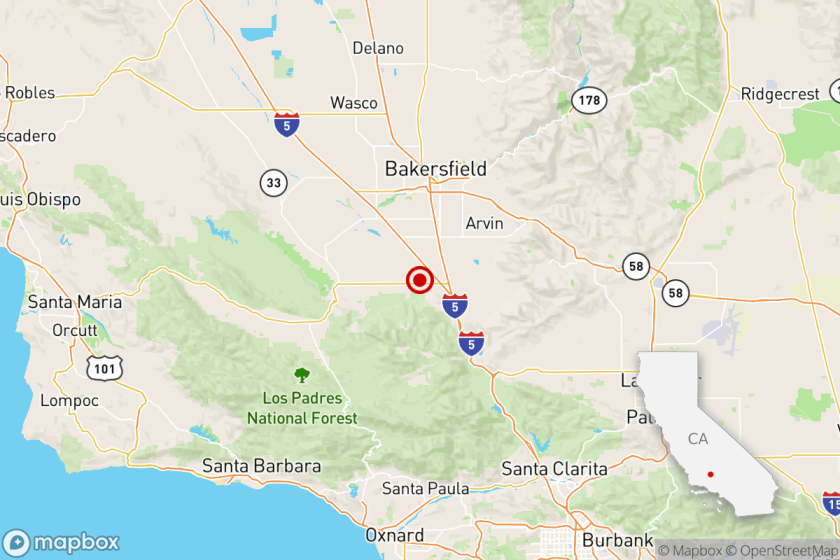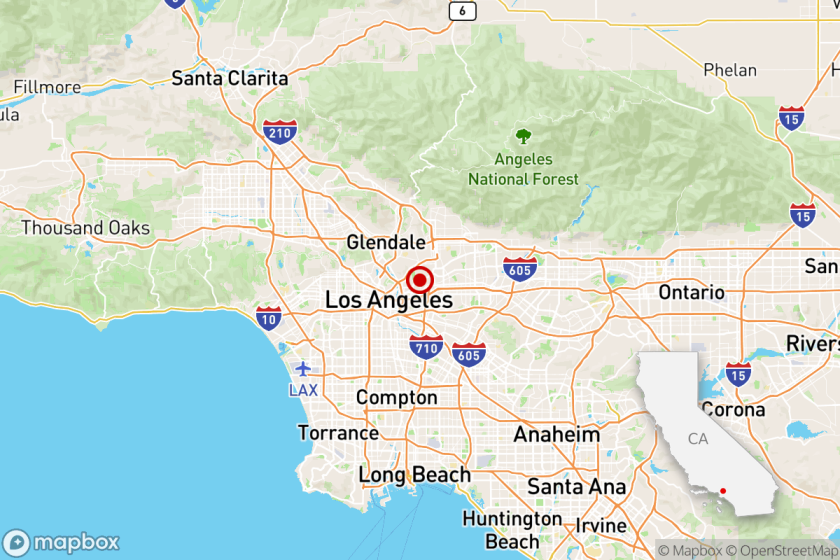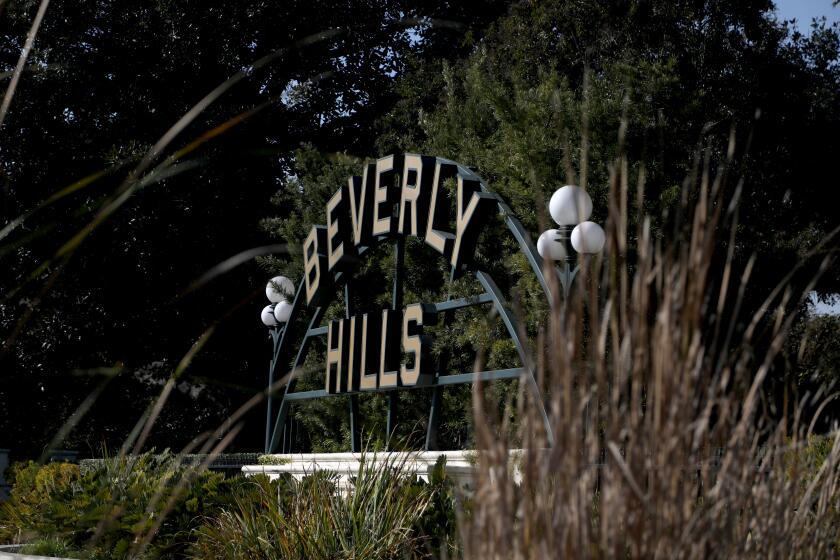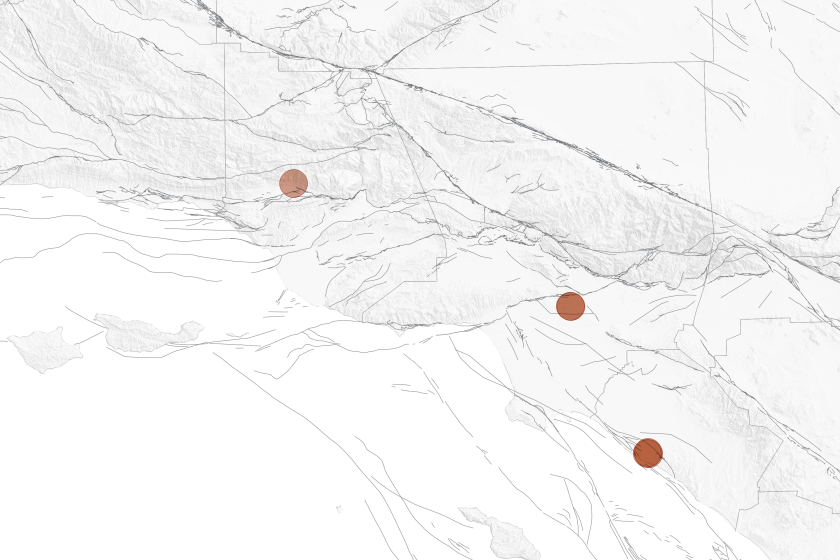Quake Plan Rolls Through Wrinkle-Free Shakedown
Within 10 minutes of last Thursday’s earthquake, local radio stations KVEN and KHAY were informing listeners that a big temblor had struck Los Angeles but that Ventura County’s hospitals, dams, government buildings, freeways and schools had sustained no damage.
For all those who felt the shock, the news allayed fears. Loved ones on freeways and in offices were safe. Dams held. No fires threatened.
How was this news collected and broadcast so quickly?
Part of the answer lies in a basement room at the County Government Center that is manned by dispatchers and outfitted with wall maps, emergency phones, television monitors, radios, audio-visual equipment and electronic equipment linking the center with utility companies and radio stations. And part lies in the smooth workings of an emergency-preparedness plan that county officials have honed after each potential disaster but time and again have hoped that they would never have to use.
Network in Place
Officials have set up a countywide network of people instructed to call or radio the Emergency Control Center with reports of damage as soon as possible after discovery of a fire, flood or other catastrophe. The callers include government personnel, hospital directors, Red Cross workers, dam-keepers, utilities workers, ham-radio operators and 25 or so others.
Response on Thursday was swift. Officials say they are pleased with the results, and even more heartened that Ventura County was spared.
Amateur radio buffs called the center with an initial “no damages” report seven minutes after the ground stopped shaking, said Karen A. Guidi, assistant director of the county’s Office of Emergency Services. Armed with an assessment confirmed by 50 ham-radio operators, Guidi, in turn, called the local radio stations.
“I was pleased. The plan we have worked very well,” she said.
Of course, Guidi concedes, things might have been different had the epicenter been in downtown Ventura instead of Whittier’s business district.
As it was, she was able to get telephone reports from all her field sources within 20 minutes, she said. There were no phone-line failures, and the backup radio system that officials have designed in case of emergency was never put to the test.
Emergency officials remained unruffled by Sunday’s aftershock, which Guidi and some other emergency officials say they didn’t even feel.
“It was pretty quiet. . . . There were a couple of checks made on a limited scale . . . to cities, with police stations. We didn’t go through the whole procedure again,” Guidi said.
Dam Keeper’s Day
A former emergency-room nurse who has done emergency medical and disaster planning for Ventura County since 1981, Guidi’s instincts are sure, her demeanor calm.
Equally collected was Dwight Clements, dam keeper since 1978 of the Casitas Dam, who had to steel himself for an underground inspection. “It’s not a happy thought when you’re down in there and you think of the earth moving,” he said.
Moments after the big quake, Clements, who lives with his family in a house just below the dam, south of Ojai, descended into a concrete tunnel underneath the dam floor and 260 feet below the water line to check for damage such as leaks and cracks.
Richard Hajas, operations and maintenance supervisor for the Casitas Municipal Water District, said that engineers also monitor seismic motion, water pressure and flow. They scan dam walls and surfaces, looking for “absolutely anything that indicates movement,” Hajas said.
In case of complete dam failure, the district might have to evacuate up to 15,000 West Ventura residents whose homes would lie in the path of raging waters, Hajas said.
But county officials say it probably will not come to that. They say the county’s three dams--Santa Felicia in Piru and Lake Bard in Camarillo are the other two--are built to withstand an earthquake magnitude of more than 8.0. Thursday’s registered 6.1 on the Richter scale.
So are Ventura County’s approximately 500 government buildings, ranging from restrooms to the county courts.
Because much of Ventura County’s growth has occurred under the more stringent earthquake-construction requirements of recent years, county officials expect they would suffer less damage than Los Angeles even if a big quake struck, said Art Goulet, director of the county’s Public Works Agency.
Dress Rehearsal
Last week’s quake served as an unexpected dress rehearsal for a countywide emergency-preparedness drill that officials have long planned for next Wednesday and Thursday. But the Los Angeles temblor has now pushed back that date to January or February of 1988.
The run-through “will be a total test of the back-up system. Each city will activate the backup radio system and go through simulated emergency proceedings,” said Paul Gagnon, Ventura County’s radio officer, who heads the Radio Amateur Civic Emergency Services (RACES).
Calls Go Out
Gagnon said that, when the real thing struck last Thursday, ham-radio operators immediately put out an urgent call for damage reports to the about 300 RACES members from Thousand Oaks to Oxnard. Within minutes, 50 replies were whipping through the short-wave frequencies, Gagnon said.
“Everyone’s sitting there with their walkie-talkies and they can report what they see. We’ve got a lot of people with a lot of eyeballs,” he said.
An hour or so later, Guidi and several sheriff’s deputies got a bird’s-eye view as they flew over Ventura County in a helicopter as part of an aerial reconnaissance team.
“We had a checklist of all the hospitals, dams, schools, government structures and high-rise buildings in Ventura County. We targeted and identified every one of them,” said Jan Smith, an administrative assistant for the Office of Emergency Services who was aboard the helicopter.
Other Disasters
But the office is called upon to report more than earthquake destruction. Ventura County’s emergency plan also addresses floods, fires, tsunamis, nuclear disasters, toxic-chemical spills and other man-made or natural disasters.
Fire Relief
In 1985, for instance, the four staffers in the Office of Emergency Preparedness were kept busy working on fire relief after the devastating forest fire that encircled Ojai. They also spent months after the fire preparing for winter floods that never materialized.
Today, staffers spend much of their time planning for emergencies that they hope will never happen. They also conduct seminars for civic groups, schools and neighborhoods on how to prepare for emergencies.
Seminar requests have at least tripled since Thursday’s quake, staffers say.
Guidi, for one, knew exactly what to do when the earthquake rumbled across her East Ventura home as she walked out the front door for work.
She ran back inside and crawled under her dining-room table.
“It’s called ‘duck, cover and hold.’ We teach it to kids. We teach it to dogs. We teach it to anyone who will listen.”
More to Read
Sign up for Essential California
The most important California stories and recommendations in your inbox every morning.
You may occasionally receive promotional content from the Los Angeles Times.






